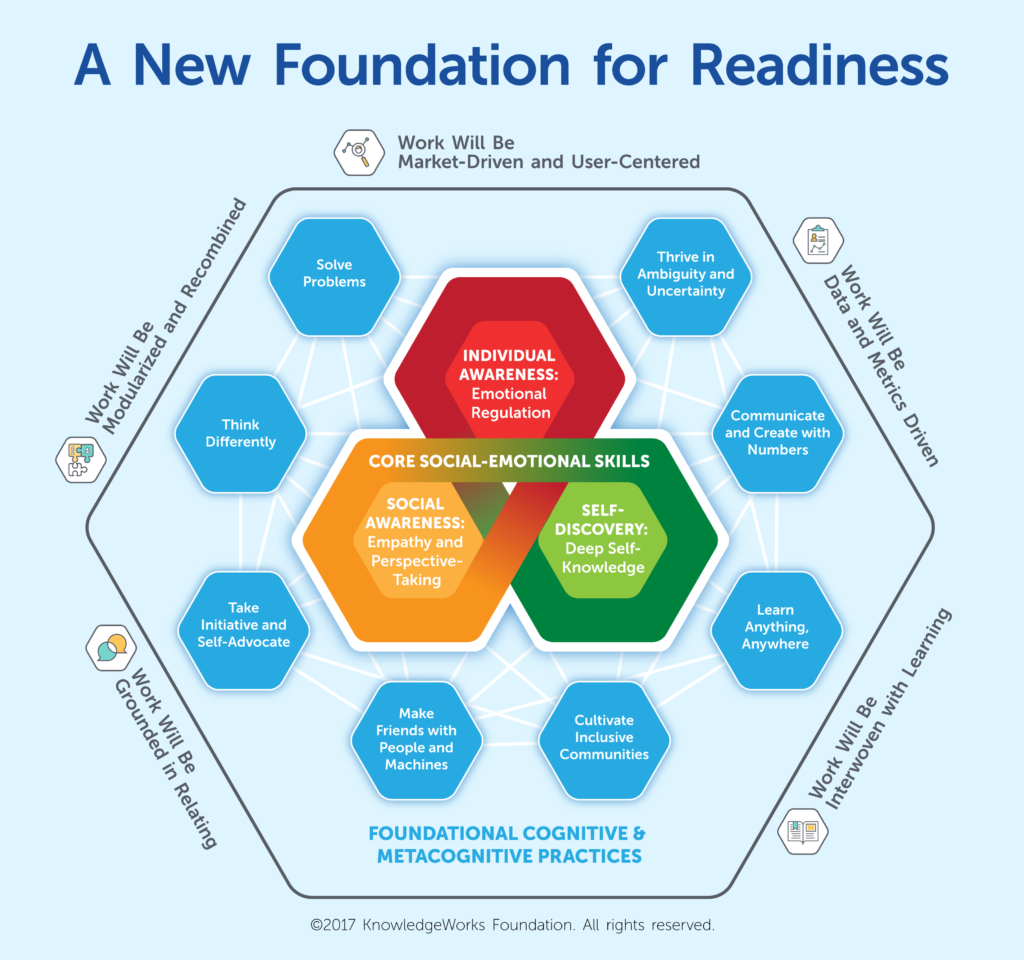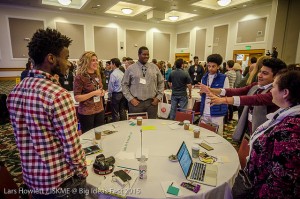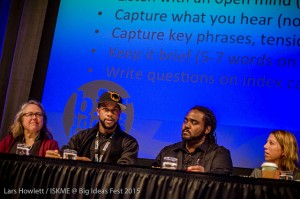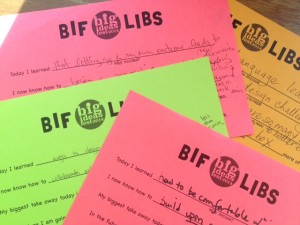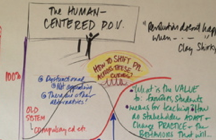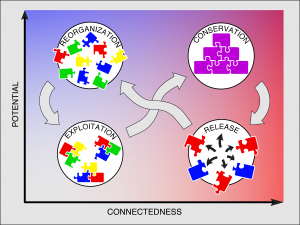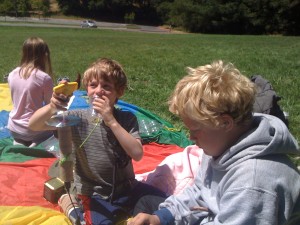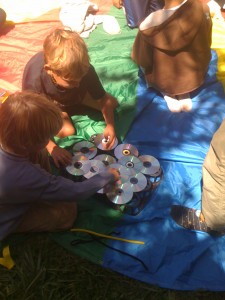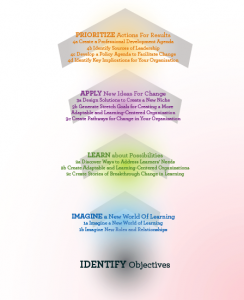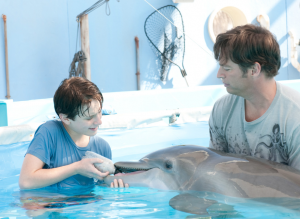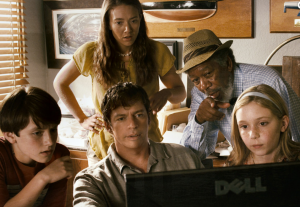Education stakeholders currently share a common vision of preparing students for career and life. However, the transformation of work driven by accelerating technologies is challenging our understanding of readiness and the very nature of career itself. Indeed, as digitally automated and augmented work diffuses across industries and reshapes the productive contributions of humans, traditional notions of career may actually limit opportunities for success. Rather, a more robust process of cultivating a creative life may be more effective in helping students develop the capabilities, motivation, and self efficacy to thrive in the emerging era of smart machines. Educators, counselors, parents, and other stakeholders would benefit from an understanding of the shift from career to creative life in order to effectively support students for long-term well-being and success in the future.
The Need for Passion and Creativity at Work
The rise of smart machines, global production networks, and technological acceleration are transforming the work landscape. Technological job displacement through automation is widely accepted, yet the pace and scope of its impact are still unfolding. A University of Oxford study reports that 47% of current US middle class jobs are at risk due to automation over the next twenty years. While the McKinsey Global Institute suggests that 45% of the activities that workers do today could be computerized. Others forecast that technology will redefine work and create new jobs rather than destroy them.
Central to the evolution of jobs and meaningful productive work in the future will be the demand for human creativity, curiosity, imagination, and emotional intelligence. Indeed a key element of success in an innovation-driven economy is the ability to leverage human passion and imagination in the pursuit of new ideas and possibilities. Supporting and amplifying these uniquely human capabilities will bring success and competitive advantage to organizations across industries. And as smart machines perform more cognitive, “knowledge work” tasks, these human super powers will be critical for a fruitful professional and personal life. As John Hagel, co-chair for Deloitte’s Center for the Edge advises,
“Find a passion. Find something you’re really, really passionate about, and don’t stop until you find it. Once you find it, find a way to make a living out of it because that’s the only way you’re going to thrive in the new world.”
In the emerging work environment, the productive individual is a creative producer of original ideas and approaches, building a portfolio of work that is the unique personal and professional signature of the individual. This means more than cultivating a personal brand. It means discovering and developing an expression of the individual’s creative identity applied to the problems and challenges of her broader productive community.
As automation permeates work, the uniquely human meta-cognitive strengths will form the basis of new jobs, work projects, and lifelong productive pursuits. Educational institutions (including those serving K12, postsecondary, and higher education students, and lifelong learners) will need to prioritize and re-orient around two insights:
- Effective educational preparation and readiness will need to prioritize its focus on the development of a strong human social-emotional core and self-concept to provide an engine for curiosity, creativity, lifelong learning, positive relationship building, and resilience; and
- Career development processes and supports will need to shift from an external orientation based on short-term market needs and static job requirements to a focus on cultivating a creative life.
These two insights are critical guiding principles for educators as they design learning experiences and programs intended to prepare students for long-term success in an increasingly automated world.
A Social-Emotional Core for Readiness
An effective readiness approach for the emerging world of work will be built on a strong inner social-emotional core. As described by the KnowledgeWorks Foundation in Redefining Readiness from the Inside Out, attending to the fundamental human capabilities of self discovery, individual awareness (emotional regulation) and social awareness (perspective taking and empathy) is essential to effective progress in other foundational cognitive and meta-cognitive capabilities that are critical to the emerging world of digitally automated and augmented work. Failure to address and develop the fundamental human capabilities will constrain success and well-being in the future world of work.
Among foundational practices (see figure above), problem-solving, thinking differently, creating with numbers, making friends with people and machines are critical capabilities for creative production and innovation. These capabilities draw heavily on a deep sense of self and resilience that grow from skilled awareness, understanding, regulation, and management of human emotions. Individuals without these skills will not be able to weather the rapid change and volatility of the workplace. They will struggle to effectively respond to the imperative to build productive relationships and maintain the agility and motivation to learn.
A Focus on Cultivating a Creative Life
While automation is elevating the importance of bringing uniquely human capabilities to work, it also is disaggregating work from institutions causing it to become distributed across online markets and platforms. Employment will be increasingly arranged, evaluated, and coordinated by algorithms enabling the growth of online talent platforms, contingent work contracts, algorithmically managed project-based work, and professional nomadism. In the context of fragmented employment and projects, how might individuals construct a narrative of their professional lives and make choices that contribute to a fulfilled life?
The desire to learn and continue on a journey of self development will propel successful individuals through the job and work choices of the emerging era of work. Individual initiative and self efficacy will be essential for building coherent work strategies through potentially turbulent and rapidly changing employment environments. The traditional notion of career — with its predetermined, linear path of work and codified skill development — is not robust enough to help to organize a professional life. Likewise, most career management models are aligned to industrial era work and are not sufficient for the kinds of personal and professional development necessary to be successful in a creativity and passion driven economy.
The table below describes the shift from managing traditional careers of the industrial era to cultivating creative lives in an era where human contribution at work is derived from imagination and creativity.

Source: Saveri Consulting, 2017; derived from Marc Zegans, Arc and Interruption
Strategic Implications for Educators
Education leaders have an opportunity to re-examine their school models, programs, services, and learner experiences to understand how they might support their students in developing a creative life in the rapidly emerging world of smart machines and digitally automated and augmented work. Specifically, educators should identify and focus on ways to support students in developing a robust self-concept with tools and capabilities necessary for professional creative production and practice.
Below are some opportunity areas to consider for supporting students in developing a creative life, with examples of current programs and initiatives.
Help students build robust inner selves
Schools that fully integrate social-emotional learning across curriculum and school community life will provide students daily practice in building and integrating essential emotion management skills. This will help students recognize and appreciate emotion management as a core tool for self care, creative engagement, and identity development as they encounter the joys and challenges of learning in a socially dynamic school community. Comprehensive social-emotional curriculum programs such as the RULER program and other CASEL programs are evidence based programs that work with educators to develop their social-emotional skills and implement curriculum into preK-12 classrooms and after school programs.
Develop multidisciplinary, thematic learning that drives self-examination
Creative production emerges from discovery, uncertainty, conflict, challenge, emotion, and expressive desire. To develop their creative thinking, expression, and problem solving capabilities students need to engage in relatable experiences and real world issues. Particularly in middle and high school years, they need to care and be activated by real world phenomena that spark awe, compassion, outrage, and joy. With greater self-discovery students will find passions that direct their creative energy and learning.
Schools such as SF BrightWorks, Tahoe Expedition Academy, Big Picture Learning, and Finland’s approach to phenomenological learning are examples of multidisciplinary, thematic, learner-centric education that puts individual student discovery and sense-making at the center.
Develop assessment frameworks that reveal uniqueness not averages
Most students experience assessments as competitive comparisons with their peers that highlight their deficits. Report cards and transcripts focus on reporting average and reductive scores (GPA, SAT, ACT) rather than unique strengths, experiences, and possible future directions as a creative individual and learner. The Mastery Transcript initiative is a collective of high schools collaborating to develop an alternative model of assessment, crediting and transcript generation that serves students by creating a unique, visual graphic that illustrates a student’s individual learning, growth, and experiences. Students demonstrate their mastery of skills, knowledge and habits of mind by presenting evidence of their work that is institutionally assessed. The electronic Transcript allows college admissions, counselors, parents, or students themselves to click through any part of the graphic transcript to get a deeper story about the individual student’s body of work. The Mastery Transcript has the potential to shift a student’s school experience (and college admissions) toward more authentic engagement around and discussion of a her personal development and expression as a learner and creative thinker in the world.
Support teachers as creative designers
Teachers create learning experiences, inquiry-based project engagements, social and emotional climates in their classrooms, and various growth opportunities for their students every day. As creators and designers, they are important role models for their students. Teacher professional development and training should shift toward supporting their growth as creative designers of social-emotional, academic, and community/civic experiences. ISKME’s Action Collab program and the Teachers Guild are dedicated to developing the capacity of teachers as creative designers and innovators by offering training and a peer community for user-centered design and problem-solving techniques that they can bring back to their schools and classrooms.
Refocus teacher preparation programs on human development
Teacher training institutions need to re-examine their programmatic approaches and priorities to ensure that new teachers gain a meaningful understanding of the shift to the emerging era of digital automation and its implications for human learning and ongoing self-development. With this background they will be able to design learning experiences, assessments, and communities that best support student wellbeing in the future. Specifically, new teachers should be well equipped with social-emotional intelligence skills. It will be necessary for them to create appropriate and productive emotional climates in their classrooms and apply emotion-based skills to manage their own professional practice as well as guide students through their social-emotional self-development. A recent CASEL study shows that SEL is lacking in most teacher certification policies and in the coursework of colleges for teacher education. In particular, they note that teacher self-awareness and self-management skills could potentially contribute to improving the rate of teacher burnout.
These are just a few concrete examples of the ways that schools can begin to support students as creative producers in an increasingly automated world. School senior administrators, principals, trustees, and school boards should consider the shift from career to creative life in their strategic planning, communications, and marketing efforts to ensure their schools are aligned with the future of work and professional life.
To learn more about the implications of Redefining Readiness for your school or organization’s strategy, and the rise of creative production click here.

